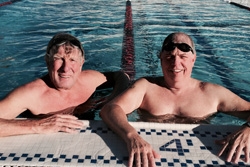It started off as just another day in 2009 for 66-year-old Jerome Smith, beginning with swimming sprints at the Culver Pool and continuing his health and wellness regimen with some time at the Bikram Yoga Studio on La Cienega Boulevard.
As Smith was going through his yoga routine, he began feeling overheated and exhausted. He didn’t know what was happening at first, so he decided to take a long, cold shower in the studio’s locker room.
After he got dressed, he emerged from the studio to an empty parking lot. Everyone in the class had gone home.
When Smith got into his car and put the seat back to rest, that was when it happened—a heart attack.
Smith said he felt like he got hit by a bus and knew immediately what was happening. He reached for his cellphone, dialed 9-1-1 and literally screamed into his phone for help. Paramedics arrived about seven minutes later and transported Smith to Cedars-Sinai where doctors inserted four stints in his heart. Smith spent 10 days in intensive care.
“It’s a weird feeling when your heart stops pumping because it feels like you’re out of breath,” Smith said. “The sensation is like, ‘I can’t breathe’ but the fact of the matter is, you can breathe and the fact that I was screaming and yelling and all pissed off is probably what saved my life.”
Doctors told Smith that the screaming he did to get the paramedics to him caused adrenaline to rush into his system, which they say stabilized him and kept him going until paramedics arrived.
“It just wasn’t my time,” Smith said. “I just knew it wasn’t my time.”
Smith was right, because within two weeks of leaving the hospital, he was back where he belonged—in a swimming pool.
“I was angry and when I get angry, I get defiant so I plunged back into the swimming as soon as I possibly could,” Smith said.
Smith, now 73, has made good on that promise in the intervening years, having competed in the 200 Meter Medley Relay of the Southern Pacific Masters Swimming Short Course Meters Championships in Commerce, California earlier this month. Smith placed third in the 70-75 age category.
Smith was able to compete in the race because he belongs to Southern California Aquatics (SCAQ), the largest Masters swimming program in the United States.
Smith admitted that when he first joined SCAQ, he couldn’t even swim to the end of a 25-yard pool. But having been on his bucket list since college, swimming was something he was determined to do.
He began by going to swim practice for an hour every day at the Culver Pool. He would also go swimming at the pools at Santa Monica College and Loyola Marymount.
Smith said the heart attack damaged his heart and destroyed his endurance. His heart currently pumps at 35 percent of how it was operating before the attack, meaning that he was worse off than before he ever started swimming at age 55.
Smith got help in the form of Rada Evans, a SCAQ coach and former member of the 2000 U.S. Olympic Swim Team. Together, during private lessons, they worked on improving both his stroke and endurance.
“I took a half dozen lessons with her and really, really perfected my stroke and improved my speed a whole lot,” Smith said.
Since his heart attack, Smith has taken a keen interest in the subject of health. One of the exercises Smith does to keep himself in shape is a technique he learned from a study performed by the Mayo Clinic on cardiac rehabilitation.
The study recommended performing an exercise activity as hard as you can for as long as you can and then resting for a brief one-minute period. The cycle is then repeated a few more times until exhaustion.
Smith puts this into practice every time he’s at the Culver Pool, swimming 50 meters as fast as he can, which for him, is usually around 43 seconds, before he stops to rest for a minute and then repeats the cycle.
“The study found that when you go to your maximum capacity, it releases all kinds of enzymes and hormones in your body that otherwise wouldn’t get produced and those are very stimulating to longevity and health and rehabilitation,” Smith said.
Another area that has fascinated Smith since his heart attack are the rapid advancements in medicine and medical technology.
“The doctor told me that if I had had that heart attack a couple of years later, they could have injected my heart with stem cells and it would have prevented the development of scar tissue,” Smith said.
To keep himself in shape, Smith swims daily, weight trains at home three days per week, takes supplements, and drinks homemade vegetable juice that he makes with a juicer.
“I’m really focused on learning how to stay alive,” Smith said.
Smith’s short-term goal is to get himself to a point where he can swim 50 meters of butterfly and backstroke so he can compete in more swim meets in those categories.
His longer term goal is to compete in a triathlon next summer. Smith figures the training for that will take him about six months.
Looking toward the future is what Smith says helps him stay positive about life despite his advancing age. He calls swimming a sure cure for depression.
“There’s nothing like that endorphin rush that you get when you finish a good hard workout,” Smith said. “You feel like you’re walking on air.”














